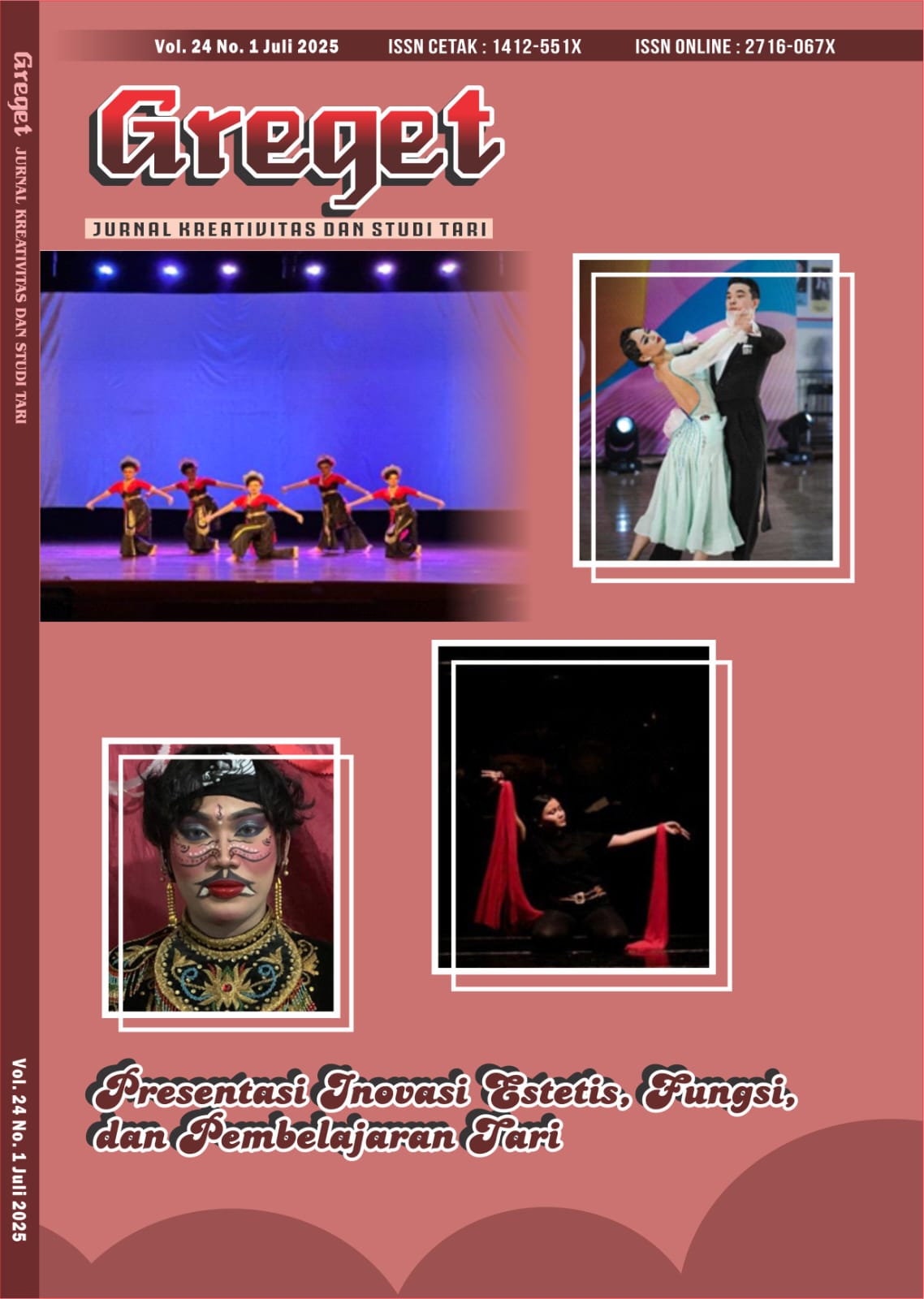TARI NHAY LARA RUDA: SEBUAH REFLEKSI HUMANISME PEREMPUAN TIONGHOA MUSLIM
Main Article Content
Abstract
This study explores the creative process behind the Nhay Lara Ruda dance by Salsabila Alfi Latifah, focusing on six fundamental components: (1) source materials, (2) personnel, (3) facilities, (4) tools and equipment, (5) influencing factors, and (6) creative considerations. The analysis of the dance form is divided into two key aspects: (a) the physical form—comprising elements that are perceptible through the five senses, such as movement, music, props, and floor patterns; and (b) the expressive form—which encompasses aesthetic and symbolic meanings. This analytical framework is informed by Rustopo’s perspective, as cited in Sejarah Tari Gambyong: Seni Rakyat menuju Istana, which conceptualizes artistic form as the embodiment of an artist’s internal experiences, made manifest through tangible media. It emphasizes the dynamic interplay between form (wadah) and content (isi). The notion of garap (creative composition) follows Rahayu Supanggah’s theoretical model, which underscores the synthesis of technical execution and artistic intuition. Employing a qualitative research methodology, the study utilizes a combination of performance analysis, literature review, in-depth interviews with selected informants, and direct observation of the Nhay Lara Ruda choreography. The findings indicate that the dance originates from an aesthetic vision and symbolically portrays the character and life journey of Nhay Lara Ruda. The work serves not only as a form of artistic entertainment but also as a symbolic narrative of perseverance and the human pursuit of happiness.
Downloads
Article Details

This work is licensed under a Creative Commons Attribution-ShareAlike 4.0 International License.
Copyright
Authors who publish with GREGET agrees to the following terms:
- Authors retain copyright and grant the journal right of first publication with the work simultaneously licensed under a Creative Commons Attribution-ShareAlike 4.0 (CC BY-SA 4.0) that allows others to share the work with an acknowledgment of the work's authorship and initial publication in this journal.
- Authors are able to enter into separate, additional contractual arrangements for the non-exclusive distribution of the journal's published version of the work (e.g., post it to an institutional repository or publish it in a book), with an acknowledgment of its initial publication in this journal.
- Authors are permitted and encouraged to post their work online (e.g., in institutional repositories or on their website) prior to and during the submission process, as it can lead to productive exchanges, as well as earlier and greater citation of published work.
References
Bantolo, M. W. (2019). Konsep Opera dalam Penciptaan Tari Kontemporer. Surakarta: ISI Surakarta.
Burhan, B. (2008). Analisis Data Penelitian Kualitatif. Jakarta: Rajawali Press.
Fermadi, B. (2018, Januari-Juni). Humanisme sebagai Dasar Pembentukan Etika Religius; dalam Perspektif Ibnu Atha'illah Al-Sakandari. Jurnal Islam Nusantara, 2(1), 72-89. Retrieved from https://jurnalnu.com/index.php/as/article/view/71
Hadi, S. (2007). Kajian Tari Teks dan Konteks. Yogyakarta: Pustaka Book Publisher.
Hadi, S. (2012). Konsep Humanisme Yunani Kuno dan Perkembanganya dalam Sejarah Pemikiran Filsafat. Jurnal Filsafat, 22(2), 107-119. https://jurnal.ugm.ac.id/wisdom/article/view/12990/9262
Haryono, S. (2017). Pengetahuan Tari. Surakarta, Jawa Tengah: ISI Press.
Isnanta, S. D. (2010). Studi Penciptaan Karya Performance Art dengan Fokus Eksplorasi Ruang dan Cahaya. Acintya Jurnal Penelitian Seni Budaya, 219-227. https://doi.org/10.33153/acy.v2i2.167
Negara, M. A., & Muhlas. (2023, Agustus). Prinsip-Prinsip Humanisme Menurut Ali Syari'ati. Jurnal Riset Agama, 3(2), 357-371. https://doi.org/10.15575/jra.v3i2.19936
Nurpuling, E., & Subagyo, H. (2021). Garap Tari Kethek Ogleng di Desa Ngambarsari, Karangtengah Kabupaten Wonogiri (Vol. 20). Surakarta, Jawa Tengah, Indonesia: Greget Jurnal Kreativitas dan Studi Tari. https://jurnal.isi-ska.ac.id/index.php/greget/article/view/4037/pdf
Pedgley, O. (2007, September). Capturing and Analysing Own Desigh Activity. Desigh Studies, 28(5), 463-483. https://doi.org/10.1016/j.destud.2007.02.004
Rahayu, I. T. (2009). Psikoterapi: Perspektif Islam dan Psikologi Kontemporer. Malang: UIN Maliki Press.
Sari, S. R., & Hendro, E. P. (2020, Desember 1). Konservasi Kampung Pecinan Semarang sebagai Media Integrasi yang Berdimensi Multikulturalism. Endogami: Jurnal Ilmiah Kajian Antropologi, 4(1), 93-108. https://ejournal.undip.ac.id/index.php/endogami/article/view/34825
Slamet. (2014). Garan Joged: Sebuah Pemikiran Sunarno. Surakarta: Citra Sains LPKBN Surakarta.
Soedarsono, R. (1978). Diktat Pengantar Pengetahuan dan Komposisi Tari. Yogyakarta: ASTI.
Sukri, A., & N, S. (2023, Juni 1). Metode Penciptaan Tari Kontemporer "Tubuhku, Puisi yang Bergerak". Garak Jo Garik Jurnal Pengkajian dan Penciptaan Seni, 1(2), 51-60. https://journal.isi-padangpanjang.ac.id/index.php/Garak/article/view/3755
Supanggah, R. (2007). Bothekan Karawitan II: Garap. Surakarta: ISI Press.
Supendi, E., & Isnanta, S. D. (2020, Juni). Studi Peciptaan Karya Site Specific Dance "Helai Kertas". Acintya Jurnal Penelitian Seni Budaya, 12(1), 33-43. https://jurnal.isi-ska.ac.id/index.php/acintya/article/view/3140/2647
Waridi. (2005). Buku Tuntunan Pedalangan: Karawitan Wayang Kulit Gaya Surakarta. Jakarta Timur: Sena Wangi.
Widyastutieningrum, S. R., & Wahyudiarto, D. (2014). Pengantar Koreografi. Surakarta: ISI Press.
Zairani, E. S., & Cahyono, A. (2020, November 30). Koreografi dan Fungsi Tari Gagrak Maritim di Kampung Seni Kota Tegal. Jurnal Seni Tari, 9(2), 160-174. https://journal.unnes.ac.id/sju/jst/article/view/40473
